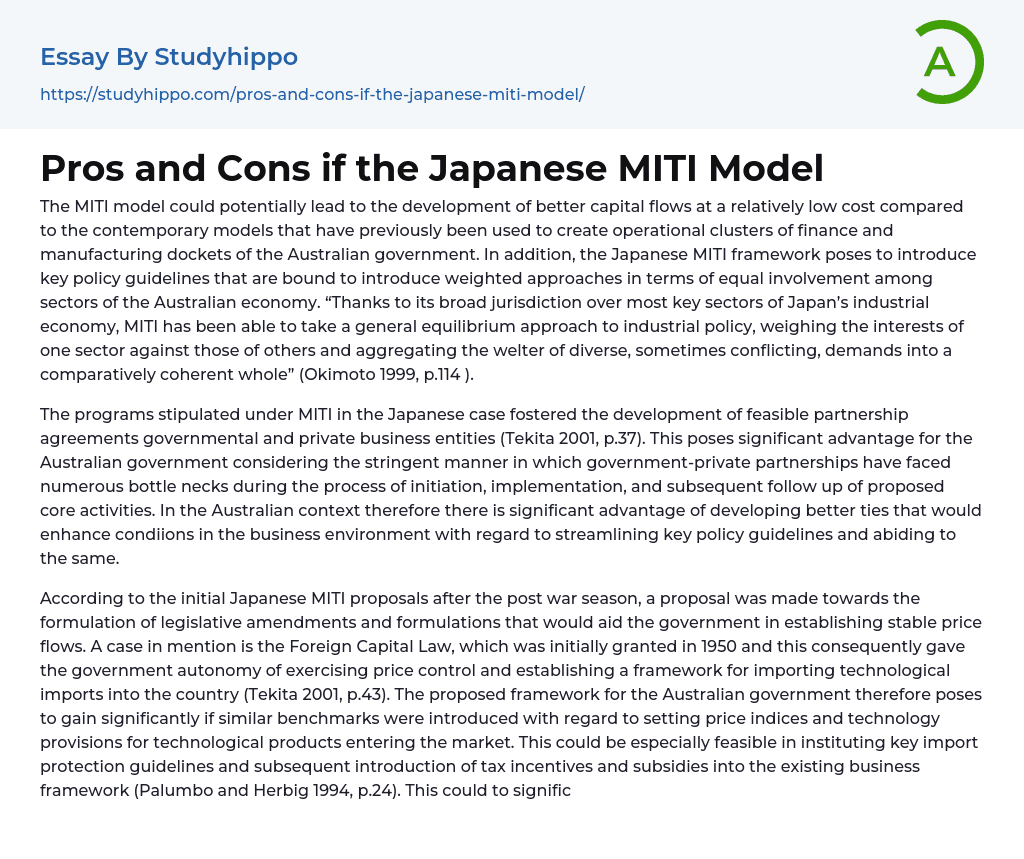
The MITI model could potentially lead to the development of better capital flows at a relatively low cost compared to the contemporary models that have previously been used to create operational clusters of finance and manufacturing dockets of the Australian government. In addition, the Japanese MITI framework poses to introduce key policy guidelines that are bound to introduce weighted approaches in terms of equal involvement among sectors of the Australian economy. “Thanks to its broad jurisdiction over most key sectors of Japan’s industrial economy, MITI has been able to take a general equilibrium approach to industrial policy, weighing the interests of one sector against those of others and aggregating the welter of diverse, sometimes conflicting, demands into a comparatively coherent whole” (Okimoto 1999, p.114 ).
The programs stipulated under MITI in the Japanese case fostered the development of feasible partnership agreements
...governmental and private business entities (Tekita 2001, p.37). This poses significant advantage for the Australian government considering the stringent manner in which government-private partnerships have faced numerous bottle necks during the process of initiation, implementation, and subsequent follow up of proposed core activities. In the Australian context therefore there is significant advantage of developing better ties that would enhance condiions in the business environment with regard to streamlining key policy guidelines and abiding to the same.
According to the initial Japanese MITI proposals after the post war season, a proposal was made towards the formulation of legislative amendments and formulations that would aid the government in establishing stable price flows. A case in mention is the Foreign Capital Law, which was initially granted in 1950 and this consequently gave the government autonomy of exercising price contro
and establishing a framework for importing technological imports into the country (Tekita 2001, p.43). The proposed framework for the Australian government therefore poses to gain significantly if similar benchmarks were introduced with regard to setting price indices and technology provisions for technological products entering the market. This could be especially feasible in instituting key import protection guidelines and subsequent introduction of tax incentives and subsidies into the existing business framework (Palumbo and Herbig 1994, p.24). This could to significant improvements when considering the Australian economy variables leading to the emancipation of critical international and local trade elements.
Cons of Implementing the Japanese MITI Model in the Australian Context
After an assessment of the Japanese MITI model implementation framework, there exist significant contextual differences. “When MITI originally planned the compilation of this history, emphasis was placed at the initial stages on Japan’s rapid recovery from war ruin subsequent rapid economic growth, and eventual achievement of an economic status that gained global attention” (Sumiya 2000, p.vi ). Some of these include the aspect of periodic differences during which the strategy was implemented in the Japanese context and the proposed move in the Australian context. For instance, the introduction of price control practices could adversely affect business potential in certain sectors. “Government controls and intervention practices distort market prices and serve as barriers to market entry” (Thakur and Srivastava 2001, p.382).
Another aspect is the introduction of the protectionism formula in the business environment, which could potentially affect delivery mechanisms and subsequent development of business potential. “As a result of the Japanese government unwillingness to remove the barriers that are resulting in such untenable trade deficits, many countries are threatening to
retaliate with anti-Japanese protectionist rules and practices” (Thakur and Srivastava 2001, p.382). This when looked at in the Australian context, could potentially affect trade relations unless significant modifications are made to the plan in order to avoid a similar occurrence.
- Australian Culture essays
- Finance essays
- International Business essays
- Macroeconomics essays
- Barriers To Entry essays
- Microeconomics essays
- Pricing essays
- Profit essays
- Consumerism essays
- Export essays
- Free Trade essays
- International Trade essays
- Compensation essays
- Monopoly essays
- Trade essays
- Industry essays
- Warehouse essays
- Economic Development essays
- Economic Growth essays
- Inflation essays
- Taxation essays
- Central Bank essays
- Monetary Policy essays
- Economy essays
- Gross Domestic Product essays
- Recession essays
- Capitalism essays
- Economic System essays
- Materialism essays
- World economy essays
- American Dream essays
- resources essays
- Max Weber essays
- Employment essays
- Minimum Wage essays
- Unemployment essays
- Human Development essays
- Income Inequality essays
- Economic Inequality essays
- Money essays
- Financial Accounting essays
- Market Segmentation essays
- Supply And Demand essays
- Purchasing essays
- Forecasting essays
- Legacy essays
- Bank essays
- Corporate Finance essays
- Financial News essays
- Financial Ratios essays



